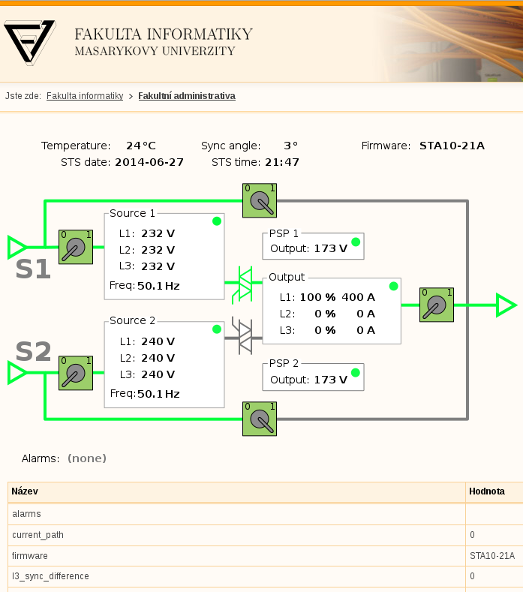Tue, 01 Jul 2014
Static Transfer Switch
Static Transfer Switches (STSs) are amongst the most important parts of power distribution in our datacenter. Some of the datacenters are designed with redundant power paths in mind (as required e.g. by TIER 3 specification). The problem with TIER 3 is, that it requires all the equipment to have two or more power supplies. Some appliances (for example, ethernet switches) are much cheaper with a single PSU. An ethernet switch with two PSUs is usually from the vendor's top line, and is of course priced as such. We have decided to design our datacenter power distribution with single-PSU equipment in mind.
According to our experience, the majority of the power outages in our previous datacenter were either the planned outages, or were caused directly by the failure of the equipment which was supposed to provide higher availability (e.g. the UPSes themselves). So we have planned the datacenter to be able to bridge around the failed part of the equipment, while still providing the uninterrupted power even for the equipment with single power supply.
An STS can be viewed as a box with two incoming power lines and one outgoing line. It monitors the incoming power paths, and can quickly switch to the alternate path, should the currently-used path become faulty, providing uninterrupted service of the outgoing power line even in case of the failure of one of the incoming power lines. The "Static" part in the name means that there are no mechanical parts involved in the switching itself (such as relays), the switching is done by SCRs:

Our STSs are Inform InfoSTS. Their communication protocol and documentation is pretty bad, so I cannot really recommend them. Their proprietary Windows-only management software is even worse. For example, an attempt to set the time fails when the time is before 10:00, because the management software sends the time as H:MM, while the STS itself expects HH:MM even for hours less than 10. I have nevertheless managed to decode the protocol and write my own web-based management application for it (screenshot above).
Probably the most interesting part is that it is the first time I used SVG inside the web page, and Javascript for modifying it when the new data is read. So the schematics can be edited in Inkscape, and provided that the object IDs are unchanged, the application layer can still work with it. I plan to connect it with MRTG or Zabbix, and make all the numbers clickable, leading to the graph of the history of that particular variable.